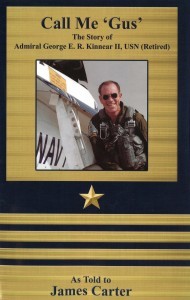 By Admiral Kinnear as told to James Carter, Dog Ear Publishing, Indianapolis, IN (2014)
By Admiral Kinnear as told to James Carter, Dog Ear Publishing, Indianapolis, IN (2014)
Reviewed by Charles Bogart
The heart of this autographical book centers around four topics the Admiral feels are important for success: have a vision of what you want to achieve, take advantage of continuing education opportunities, spend time developing personal networks, and learn how organizations function. Kinnear never directly states that this is the purpose of his book. Rather, he lets the message he wishes to convey to slowly permeate the conscientious of the reader as they follow his progression upward through the Navy’s chain of command.
As a high school dropout, Kinnear joined the U.S. Navy in the last year of World War II. Through a remarkable set of circumstances, he would advance from E-1 to O-10. Almost immediately upon joining the Navy, Kinnear realizes the limitations his lack of a high school degree places upon his desire to enter the aviation field. The story of how he used networking to get his high school degree and be sent to college by the Navy reads like a Horatio Alger story. Yet the common core of his story is that he did what was necessary to meet U.S. Navy requirements to be a pilot.
Once Kinnear received his wings, he followed a career of advancement through multiple jobs within the Navy’s aviation community. It was path heavy on education and staff duties. Every job the Navy gave him, he used as a learning exercise. This learning is not limited to his area of his responsibility, but he continually sought to learn more about the world around him. He used his tour of duty onboard the training carrier USS Antietam (CV 36) to become proficient as both a deck and an engineering officer. Examples of how a leader leads and mentors his men are laced throughout the book.
His tale of working as a Congressional liaison officer for the Navy is a tale of how to achieve goals by developing relationships with Congressional staffers and taking the time to learn how Congress works, not how it should work. He constantly emphasized that the key to success in getting a matter resolved in Congress is to find the lowest staff person who can make it happen. He included high-level networking stories of how the Ohio class submarines received their class name, how a Nimitz carrier was authorized and de-authorized, and why the F-18 was chosen over the F-17.
The book also contained an interesting number of short stories describing encounters the Admiral had with various people of power and his impression of them. What is missing from the book is information on his family or how they coped with his absences and constant movement around the country. Overall, this is an informative read concerning some of the outside and inside forces that were impacting the Navy, both positively and negatively, during the Admirals time in the Navy. The book is well worth reading by anyone interested in the Navy of the 1950s and 1960s or making a success of their life. The fundamental fact that I took away from the book is: if one wishes to succeed in this world, one must never stop learning about the world around oneself.
Charles H. Bogart is a frequent contributor to Naval History Book Reviews.


Steve Cundari
Cynthia Livingston
Cynthia Livingston